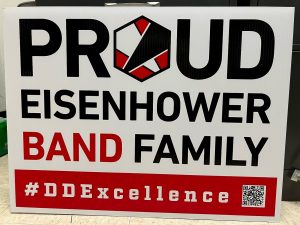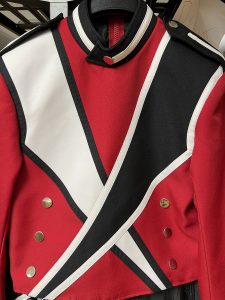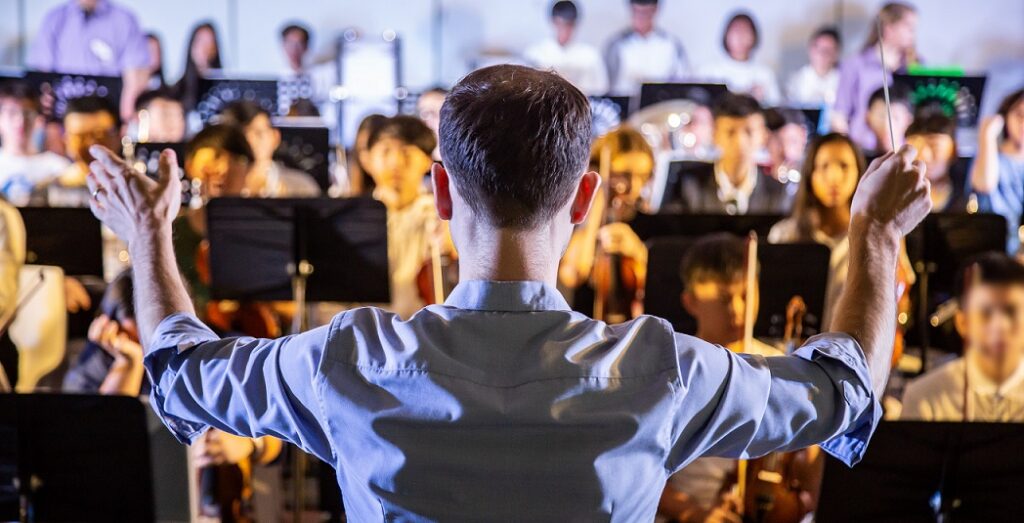The Benefits of Branding Your Band
Your band’s brand should transcend the walls of your music classroom and let the greater community in on the magic you and your students create on a daily basis.
Many professionals in the business world would agree that a company’s logo is one of the most important facets of its brand. Not only is a logo the first opportunity for a company to make a statement about its product or services, but an effective logo can make a terrific first impression on potential clients, future employees and other stakeholders. It can even strike fear in competitors.
Although music teachers are not trained marketing strategists, we are content experts who spend countless hours developing our musical skills and refining our pedagogy so that our students can benefit from the best version of ourselves. However, if we do not effectively market our product — in our cases, our students’ achievements and the authentic learning opportunities we create in our classrooms — we may alienate ourselves from the very people whose support we need to stay afloat and flourish in a post-pandemic educational landscape.
Why should our students be the only ones privy to the culture and prestige we associate with our music programs? Having a brand that transcends the walls of your music classroom is an excellent way to let the greater community and other outsiders in on the magic you and your students create on a daily basis.
Click on the links to below to read about
Why and When to Rebrand
 A brand for your school music program or a select ensemble should not just be about designing a cool logo and throwing it on a T-shirt. Rather, it should be about creating and sustaining a unified vision and mission for your program. To be clear, a vision should center around what you want your program to be, while a mission should focus on how you intend to get there.
A brand for your school music program or a select ensemble should not just be about designing a cool logo and throwing it on a T-shirt. Rather, it should be about creating and sustaining a unified vision and mission for your program. To be clear, a vision should center around what you want your program to be, while a mission should focus on how you intend to get there.
When the Dwight D. Eisenhower High School band was in the process of rebranding our ensembles, I met with current and former students and their families to determine the aspects of our program that meant the most to us and which areas could be improved. I wanted all stakeholders to have a shared vision so our program would be reflective of our students and their community. We looked at music programs from other schools that we admired and considered how we could provide similar opportunities for our program. The sense of pride you want your students to experience as a member of your music program starts with a meaningful vision and mission. Otherwise, your logo would just be a design without any substance.
Once your vision and mission are created, consider when the best time would be to brand or rebrand your program. I would caution new directors on rebranding an already established music program in a completely different direction if their school community is not ready to embrace significant change. On the same token, a rebrand may be long overdue for experienced directors who have been steering the ship on the same course for quite some time. A rebrand may be accompanied with some resistance, but if you keep your focus student-centered, you will encounter much less adversity.
CHECK IT OUT: The YAS-26 Standard Alto Saxophone
Logo Logistics
No branding is complete without an effective logo. When selecting a logo for your program, it’s important to consider the following questions:
- Will I incorporate the school’s existing logo into my new design? If so, am I able to obtain permission from the copyright holder to do so?
 Many school logos come from the same source material with varying degrees of copyright permission. Perhaps you have even encountered identical mascots from two different schools. In my hometown of Chicago, it seems as though every “Home of the Mustangs” school has the exact same horse graphic! That said, my school’s Cardinal logo is strikingly similar to our namesake from the National Football League. Because of this, I am limited by copyright as to what I can design using that particular logo.
Many school logos come from the same source material with varying degrees of copyright permission. Perhaps you have even encountered identical mascots from two different schools. In my hometown of Chicago, it seems as though every “Home of the Mustangs” school has the exact same horse graphic! That said, my school’s Cardinal logo is strikingly similar to our namesake from the National Football League. Because of this, I am limited by copyright as to what I can design using that particular logo.
- What colors do I want for my new design? Am I obligated to use a particular color scheme based on the school’s colors?
- Most school music programs that don a program-specific logo tend to use their school’s colors. If you are looking to design something exclusive to your program but do not want to create a logo completely against the grain, consider adding accents in a neutral color such as white, black, silver or gold.
- Will my logo contain an icon, text or both? If it contains text, do I need to acquire a particular font?
- Most logos contain both an icon and text, though some multi-national companies are now ubiquitous enough for their icon to stand alone from their text (e.g., Starbucks, Pepsi, McDonald’s). If you are using a popular font, you can try changing its typeface, character spacing or color to add more exclusivity to your logo.
- Who will design my logo?
- Perhaps you have a talented student who is an experienced artist. Maybe you dabble in graphic design between lesson planning and preparing for concerts. Or, maybe logo design is way beyond your purview and you outsource the job outright. In any case, use the tools and resources at your disposal to generate the best possible product based on your preferences. I happen to be a huge fan of simple designs. Many of the most popular logos in our society are simple and bold, so I wanted to mimic that idea with my own band’s logo.
- Will my logo appear electronically, in print or both? Can my logo be produced in the correct file type, size and resolution to meet my needs?
 If you want to print your logo on a banner for your marching band or other large-scale media, you must ensure the digital file is rendered in high-resolution. One of the ways resolution is measured is DPI, or dots per inch. When using a graphic meant for electronic distribution (e.g., Twitter profile, website image), 72 DPI should suffice. However, most graphics that will be printed should be at least 300 DPI. The higher the DPI, the sharper the image. Rendering high-resolution artwork will result in larger file sizes, but it will look crisper and less pixilated or grainy when displayed on larger surfaces.
If you want to print your logo on a banner for your marching band or other large-scale media, you must ensure the digital file is rendered in high-resolution. One of the ways resolution is measured is DPI, or dots per inch. When using a graphic meant for electronic distribution (e.g., Twitter profile, website image), 72 DPI should suffice. However, most graphics that will be printed should be at least 300 DPI. The higher the DPI, the sharper the image. Rendering high-resolution artwork will result in larger file sizes, but it will look crisper and less pixilated or grainy when displayed on larger surfaces.
- What are the inspirations for my design?
- In my experiences, drawing inspiration from the school and its surrounding community is a great way to establish a sense of pride about an organization and generate local support from outside your program. Creating a new iteration of an existing logo adds a breath of fresh air to an ensemble steeped in tradition; designing something totally different breaks from the norm and portrays a willingness to embrace change. Both ideas convey something different, so it is best to consider the potential impact your branding will have on your program, school and community.
Our Rebranding Story
 I had a prime opportunity to rebrand our marching band in 2013 when our school board approved the purchase of new uniforms. At the time, we did not have a band logo or any real identity. Our uniforms were almost 25 years old, and they were mostly black with very few design elements. About a third of the uniforms were missing buttons, most did not fit properly, and some were torn from years of use. Suffice to say, no one was particularly enthusiastic about suiting up for a football game or festival.
I had a prime opportunity to rebrand our marching band in 2013 when our school board approved the purchase of new uniforms. At the time, we did not have a band logo or any real identity. Our uniforms were almost 25 years old, and they were mostly black with very few design elements. About a third of the uniforms were missing buttons, most did not fit properly, and some were torn from years of use. Suffice to say, no one was particularly enthusiastic about suiting up for a football game or festival.
My administration gave me carte blanche to design whatever I needed to take our image from the early ’90s to the 21st century. With our school colors being red and white, I wanted a bright uniform that would stand out on a football field and make a statement of authority. I worked with a local artist and graphic designer and ultimately opted for the design shown here.
 Over the course of that year, our band formed an identity steeped in our new vision and mission of empowering one another. We decided that helping other members of our organization become the best version of themselves was just as important as achieving individual success. Our students began sharing responsibility for their own learning and holding each other accountable. We intentionally and collaboratively designed rehearsal plans to keep our organization advancing toward our goals. We sought to be the band that tried together, failed together and triumphed together.
Over the course of that year, our band formed an identity steeped in our new vision and mission of empowering one another. We decided that helping other members of our organization become the best version of themselves was just as important as achieving individual success. Our students began sharing responsibility for their own learning and holding each other accountable. We intentionally and collaboratively designed rehearsal plans to keep our organization advancing toward our goals. We sought to be the band that tried together, failed together and triumphed together.
Equipped with a bold new uniform that gave us a new found sense of confidence and pride, we drew inspiration from its design to create our logo. From that point, we flooded our neighborhood with this brand and made our band program’s success — even the smallest of victories — synonymous with our community.
 Every elected official in our community has a band T-shirt with our logo on it. Our band parents have yard signs, window clings and face masks, among other merchandise proudly displayed throughout our community. Every 8th grader from each of our feeder schools receives a brochure with our course offerings on letterhead with our logo proudly displayed. Now that we are several years into our rebrand, we have successfully used our logo in different iterations separate from our original design to showcase specific productions from year to year.
Every elected official in our community has a band T-shirt with our logo on it. Our band parents have yard signs, window clings and face masks, among other merchandise proudly displayed throughout our community. Every 8th grader from each of our feeder schools receives a brochure with our course offerings on letterhead with our logo proudly displayed. Now that we are several years into our rebrand, we have successfully used our logo in different iterations separate from our original design to showcase specific productions from year to year.
Think about when you were first hired as an ensemble director. Reflect on the level of enthusiasm you possessed when you were FINALLY empowered to build or shape a music program the way YOU wanted. If that fervor has begun to wane, especially since navigating through the pandemic, a rebrand could help reignite your passion and set you and your students on a trajectory to achieve greater personal fulfillment through your collaborative music-making.

















